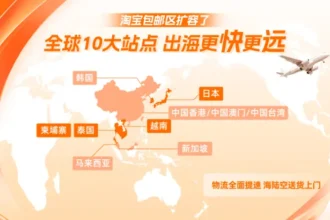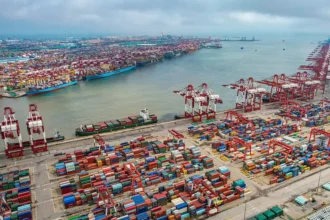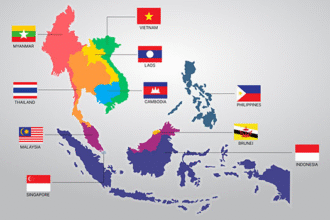In 2024, Cambodia’s GDP per capita surpassed USD 2,713, crossing the “threshold” for launching a capital market for the first time. With sustained macroeconomic growth, a gradually improving institutional framework, and a growing awareness of corporate financing, Cambodia’s capital market is undergoing an unprecedented transformation
Currently, a wave of IPOs driven by policy incentives, industrial transformation, and international capital convergence is rapidly taking shape. This marks not only a key signal of Cambodia’s economic leap but also a strategic window for investors and enterprises to multiply their assets.
IPO Boom Taking Off: Policy, Economic, and Consumer Forces in Triple Resonance
With macroeconomic growth accelerating, national strategies in place, and a gradually improving institutional framework, the foundation for Cambodia’s capital market to take off is now fully established.
1.Per Capita GDP Surpasses the “Capital Market Threshold”
International experience shows that when a country’s per capita GDP surpasses the $2,000 mark for the first time, its economy typically enters a critical phase of industrial upgrading and consumption expansion, accompanied by rapid capital market development. For example, after breaking the $2,000 threshold, the total stock market capitalization over the following decade grew significantly in several economies: Mainland China (537%), Hong Kong (192%), Malaysia (541%), Thailand (360%), and Vietnam.
In 2024, Cambodia’s per capita GDP reached $2,713, officially crossing this “take-off threshold” for capital market development. This milestone signals accelerated capital accumulation, rising corporate financing demands, and that the key conditions for launching a robust capital market are now largely in place.
In 2025, Cambodia’s economic growth is projected to reach 6.2%–6.3, with per capita GDP expected to surpass $3,000. This will provide a sustained supply of assets and valuation support for the capital market.
At the same time, urbanization and the expanding middle class are driving a growing awareness of personal finance. As a result, demand for asset allocation is rising rapidly, fueling broad interest in capital market instruments such as stocks, mutual funds, and bonds.
2. Strong Policy Momentum and National Strategic Support
At the national development level, Cambodia’s “Pentagon Strategy” clearly outlines the country’s industrial priorities for the next decade, positioning the capital market—as a core component of financial infrastructure—as a key pillar in its implementation.
The government is actively encouraging companies to broaden their financing channels and accelerate transformation through mechanisms such as Initial Public Offerings (IPOs). Financial services are increasingly becoming the “financing engine” and “resource allocation hub” of the Pentagon Strategy.
To meet the demands of this transformation, Cambodia’s capital market is unleashing institutional dividends to enhance its market absorption capacity.
The Cambodia Securities Exchange (CSX) has set development goals for 2025: doubling daily trading volume to $300,000, opening 15,000 new investor accounts, and attracting at least six new companies to list.
At the same time, continued improvements to key regulations such as the New Investment Law and Securities Law—aim to strengthen investor protection and regulatory standards.
The draft Master Plan for the Development of the Securities Market (2025–2035) lays out a ten-year blueprint for a comprehensive capital market framework, covering financing, liquidity, governance, and information disclosure.
To enhance market appeal, the government has also rolled out a series of supporting policies, including extending corporate income tax exemptions, relaxing foreign ownership restrictions, facilitating cross-border capital flows, and streamlining the listing process. These measures aim to create a more open, transparent, and efficient market environment for both domestic and foreign investors—accelerating the high-quality development of Cambodia’s capital market.
3. Tax System Normalization Solidifies the Foundation for Capital Market Development
The Cambodian government has leveraged tax system modernization as a key entry point, implementing multifaceted reforms including legislative enhancements, digitalized tax administration, and strengthened supervision to establish a stable, transparent, and predictable tax governance framework.
Since piloting the electronic filing system in 2020 and fully implementing it in 2023, Cambodia has undergone a digital transformation in tax management. The New Tax Law enacted in May 2023 clarified tax classifications, collection mechanisms, and penalty standards, completing the legal framework.
By unifying tax identification number management, reinforcing the value-added tax invoice system, and enhancing tax audit mechanisms, the reforms have significantly improved tax collection efficiency and transparency, reduced compliance risks and costs for businesses, and boosted taxpayer confidence—thus creating a stable institutional environment conducive to capital market growth.
Furthermore, tax reforms have promoted corporate financial compliance and increased transparency of tax information, providing regulators and investors with reliable data. This effectively supports the emergence of more local companies with listing potential, driving deeper and more diversified development of Cambodia’s capital market.
The rise of Cambodia’s “listing wave” is no coincidence—it is the result of the synergy between economic transformation, national strategic guidance, and an evolving institutional environment. With maturing macroeconomic conditions, clear policy objectives, and the initial establishment of capital market systems, Cambodia is entering a “strategic inflection point” for capital market activation.
Emerging IPO Wave: Accelerated Listing Processes Across Multiple Industries
Under the dual drivers of economic recovery and institutional optimization, Cambodia’s capital market is entering a critical phase of transition from a “nurturing period” to a “leap phase.” IPOs are no longer isolated cases but are gradually forming a systemic wave.
1.Local and international financial institutions increase investment
Local banks like Acleda Bank and Hattha Bank have successfully gone public, injecting stability and setting benchmarks for the financial system. Since 2024, multiple domestic and international financial institutions have accelerated their strategic layout in Cambodia’s capital market, actively exploring cross-border cooperation and financial innovation.
2.Major companies engage the Big Four accounting firms for audits
With ongoing tax reforms and government incentives encouraging listings, an increasing number of local companies have started commissioning audits from the global Big Four firms—PwC, Deloitte, EY, and KPMG.
3.Key sectors such as manufacturing, real estate, and new energy enter IPO preparation or filing stages
Driven by export-oriented manufacturing, companies from textiles, building materials, and food processing are entering IPO advisory or filing phases, forming an early “industry + capital” integration model.
Real estate and infrastructure firms are also actively preparing IPOs to broaden financing channels.
Emerging sectors like new energy and green energy are becoming market focal points, establishing a preliminary “new economy sector.”
Given the current market momentum and policy support, the number of listed companies in Cambodia is expected to grow exponentially. It is forecasted that within three years, over 100 companies will be listed, and within five years, the total may exceed 300.
The current IPO momentum reflects a composite outcome of macroeconomic recovery, industrial strategy deepening, and institutional strengthening. It signifies a shift in Cambodia’s national development model and capital market logic.
Corporate financing is transitioning from bank debt dependency toward equity financing; the investor base is evolving from predominantly retail investors to a structure led by long-term capital. With multi-sector participation and stronger institutional support, Cambodia’s “IPO wave” is becoming a key signal and practical driver of its high-quality development strategy.
Opportunity Window for Cambodia’s Asset Multiplication: How to Seize the “IPO Wave” Dividend
The year 2025 marks a crucial turning point for Cambodia’s capital market as it transitions from the “policy-building phase” to the “market takeoff phase.” In this process of asset multiplication, how businesses and investors align with the momentum and execute precisely will determine their asset growth trajectory in the coming years.
Companies: Seize the Golden Opportunity and Transform into Capital-Oriented Enterprises
· Early Planning, Early Standardization, Early Listing: Listing in Cambodia is not instantaneous and typically requires 1-2 years of systematic preparation.
· Strengthen corporate financial systems to ensure revenue, costs, and profits are genuine and sustainable.
· Improve governance structures and build compliance systems to meet capital market disclosure and regulatory requirements.
· Engage professional intermediaries such as brokers, accountants, and law firms.
· Actively list during the policy dividend window to avoid rising listing costs caused by stricter future regulations.
Achieve Financing and Market Expansion through IPOs:
· Raise funds via IPOs to accelerate capacity upgrades and product iterations.
· Enhance brand exposure to increase bargaining power and control over upstream and downstream channels.
· Expand international market channels to realize cross-border cooperation and capital connections.
Investors: Precisely Target High-Growth Potential Opportunities
1.Focus on the “Leading Contenders” in the IPO Wave
· Industry leaders with strong market positions
· Clear financial structure and sustainable profit models
· Backed by foreign or international investment institutions
· Possess technological patents or strong international expansion capabilities
· Engage early through Pre-IPO/private placement rounds
· Use professional channels such as VC funds, Pre-IPO projects, and strategic allocations for early positioning
2.Select Targets and Participate in the Secondary Market
· Invest in small- and mid-cap growth stocks with high potential
· Focus on policy-supported sectors like finance, real estate, and energy to build a stable portfolio
2025 marks a pivotal year for Cambodia’s capital market, transitioning from the “policy construction phase” to the “market takeoff phase.” For enterprises, it represents a crucial window to drive capital-based transformation and achieve leapfrog growth; for investors, it is a golden opportunity to position early and capture multiplier gains.
The current “listing boom” is not only a result of economic growth but also the starting point for a new wave of expansion. With deepening regulations, industry clustering, and continuous inflow of international capital, Cambodia’s capital market is poised to become a key lever for driving the country’s high-quality development.









